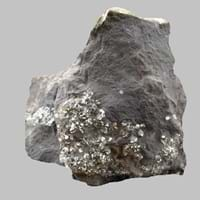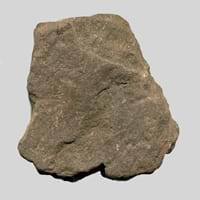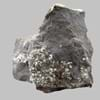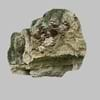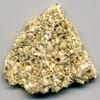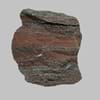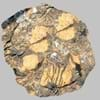Argillite and Shale
Definition
Definition
Argillites are highly compact sedimentary or slightly metamorphosed rocks that consist largely or wholly of particles of clay or silt but lack the fissility of shale or the cleavage characteristic of slate
Shale is a fine-grained sedimentary rock which is formed by the compaction of silt and clay-size mineral particles
History
Discoverer
Unknown
Unknown
Etymology
From Latin Argilla (clay) and -ite in English which became agrilla+ -ite = Argillite
From German Schalstein laminated limestone, and Schalgebirge layer of stone in stratified rock. From Old English scealu in its base sense of- thing that divides or separate,
Class
Sedimentary Rocks
Sedimentary Rocks
Sub-Class
Durable Rock, Soft Rock
Durable Rock, Medium Hardness Rock
Family
Group
Not Applicable
Not Applicable
Other Categories
Fine Grained Rock, Opaque Rock
Fine Grained Rock, Opaque Rock
Texture
Texture
Clastic, Polished
Clastic, Splintery
Color
Dark Grey to Black, Pink, Red, White
Black, Brown, Buff, Green, Grey, Red, Yellow
Maintenance
Less
More
Durability
Durable
Durable
Water Resistant
No
No
Scratch Resistant
Yes
No
Stain Resistant
Yes
No
Wind Resistant
Yes
No
Acid Resistant
Yes
No
Appearance
Rough and Dull
Muddy
Uses
Architecture
Interior Uses
Decorative Aggregates, Homes, Interior Decoration
Decorative Aggregates, Homes, Interior Decoration
Exterior Uses
As Building Stone, Garden Decoration, Office Buildings
As Building Stone, As Facing Stone, Office Buildings
Other Architectural Uses
Curbing, Whetstones
Curbing
Industry
Construction Industry
Used for flooring, stair treads, borders and window sills.
Cement Manufacture, Construction Aggregate, for Road Aggregate, Making natural cement, Raw material for the manufacture of mortar
Medical Industry
Not Yet Used
Not Yet Used
Antiquity Uses
Artifacts, Monuments, Sculpture
Artifacts, Sculpture
Other Uses
Commercial Uses
Fire resistant, Used to manufracture paperweights and bookends
Creating Artwork, Pottery
Types
Types
Not Available
Red Shale, Black Shale, Green Shale, Grey Shale and Yellow Shale
Features
Is one of the oldest rock
Easily splits into thin plates, Generally rough to touch, Very fine grained rock
Archaeological Significance
Monuments
Used
Used
Famous Monuments
Data Not Available
Jantar Mantar in India
Sculpture
Used
Used
Famous Sculptures
Data Not Available
Data Not Available
Pictographs
Used
Used
Petroglyphs
Used
Used
Figurines
Used
Used
Fossils
Present
Present
Formation
Formation
An argillite is a fine-grained sedimentary rock mainly composed of clay particles which forms from lithified muds which contain variable amounts of silt-sized particles.
Shale forms when very fine-grained clay particles are deposited in water which settle at the bottom of water bodies. They are later compacted hence forming shale.
Composition
Mineral Content
Biotite, Chlorite, Feldspar, Micas, Muscovite or Illite, Plagioclase, Pyrite, Quartz
Albite, Biotite, Calcite, Chert, Chlorite, Dolomite, Hematite, Micas, Muscovite or Illite, Pyrite, Quartz, Silica, Sulfides
Compound Content
Iron(III) Oxide, Potassium Oxide, MgO, Silicon Dioxide
Ca, Fe, Mg, Silicon Dioxide, Sodium
Transformation
Metamorphism
No
No
Types of Metamorphism
Not Applicable
Not Applicable
Weathering
Yes
Yes
Types of Weathering
Biological Weathering
Biological Weathering, Chemical Weathering, Mechanical Weathering
Erosion
Yes
Yes
Types of Erosion
Chemical Erosion
Chemical Erosion, Coastal Erosion, Glacier Erosion
Properties
Physical Properties
Hardness
2-3
3
Grain Size
Fine Grained
Very fine-grained
Fracture
Conchoidal to Uneven
Not Available
Streak
White to Grey
White
Porosity
Highly Porous
Highly Porous
Luster
Waxy and Dull
Dull
Compressive Strength
Not Available
95.00 N/mm2
20
Cleavage
Slaty
Slaty
Toughness
2.6
2.6
Specific Gravity
2.56-2.68
2.2-2.8
Transparency
Opaque
Opaque
Density
2.54-2.66 g/cm3
2.4-2.8 g/cm3
Thermal Properties
Specific Heat Capacity
0.87 kJ/Kg K
14
0.39 kJ/Kg K
23
Resistance
Heat Resistant, Impact Resistant
Heat Resistant, Impact Resistant
Reserves
Deposits in Eastern Continents
Asia
Bangladesh, China, India, Russia
Bangladesh, China, India, Russia
Africa
Ethiopia, Kenya, Morocco, South Africa, Tanzania
Ethiopia, Kenya, Morocco, South Africa, Tanzania
Europe
Austria, France, Germany, Greece, Italy, Romania, Scotland, Spain, Switzerland
Austria, France, Germany, Greece, Italy, Romania, Scotland, Spain, Switzerland
Others
Not Yet Found
Not Yet Found
Deposits in Western Continents
North America
USA
USA
South America
Bolivia, Chile, Colombia, Ecuador, Peru, Venezuela
Bolivia, Chile, Colombia, Ecuador, Peru, Venezuela
Deposits in Oceania Continent
Australia
New South Wales, New Zealand, Queensland, Victoria, Western Australia
New South Wales, New Zealand, Queensland, Victoria, Western Australia
All about Argillite and Shale Properties
Know all about Argillite and Shale properties here. All properties of rocks are important as they define the type of rock and its application. Argillite and Shale belong to Sedimentary Rocks.Texture of Argillite is Clastic, Polished whereas that of Shale is Clastic, Splintery. Argillite appears Rough and Dull and Shale appears Muddy. The luster of Argillite is waxy and dull while that of Shale is dull. Argillite is available in dark grey to black, pink, red, white colors whereas Shale is available in black, brown, buff, green, grey, red, yellow colors. The commercial uses of Argillite are fire resistant, used to manufracture paperweights and bookends and that of Shale are creating artwork, pottery.
|
||
|
||
|
